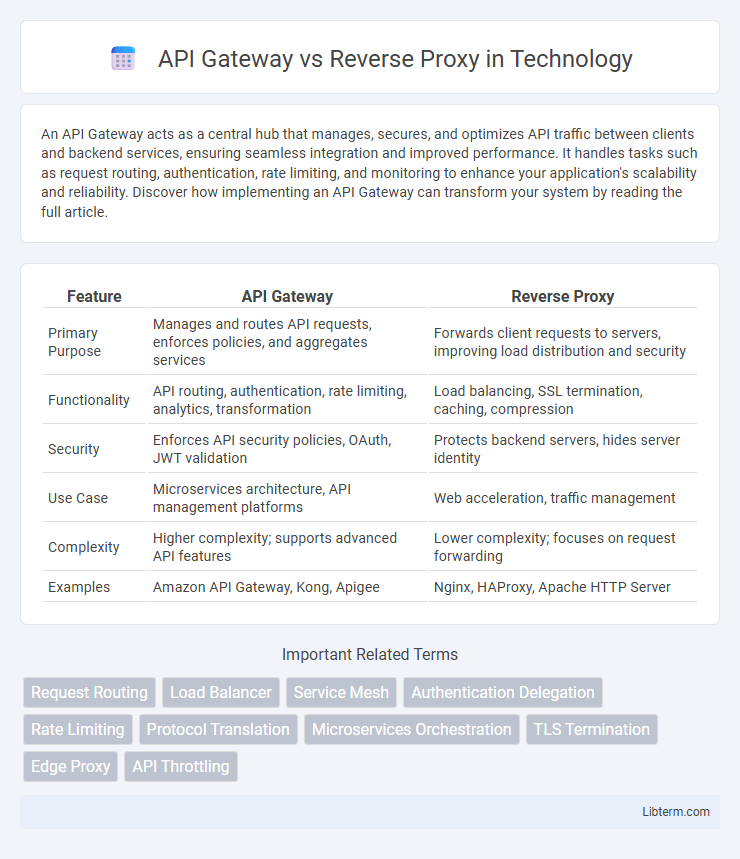An API Gateway acts as a central hub that manages, secures, and optimizes API traffic between clients and backend services, ensuring seamless integration and improved performance. It handles tasks such as request routing, authentication, rate limiting, and monitoring to enhance your application's scalability and reliability. Discover how implementing an API Gateway can transform your system by reading the full article.
Table of Comparison
| Feature | API Gateway | Reverse Proxy |
|---|---|---|
| Primary Purpose | Manages and routes API requests, enforces policies, and aggregates services | Forwards client requests to servers, improving load distribution and security |
| Functionality | API routing, authentication, rate limiting, analytics, transformation | Load balancing, SSL termination, caching, compression |
| Security | Enforces API security policies, OAuth, JWT validation | Protects backend servers, hides server identity |
| Use Case | Microservices architecture, API management platforms | Web acceleration, traffic management |
| Complexity | Higher complexity; supports advanced API features | Lower complexity; focuses on request forwarding |
| Examples | Amazon API Gateway, Kong, Apigee | Nginx, HAProxy, Apache HTTP Server |
Introduction to API Gateway and Reverse Proxy
An API Gateway manages and orchestrates API requests by handling routing, authentication, rate limiting, and protocol translation for backend services, optimizing microservices communication. A Reverse Proxy forwards client requests to backend servers, often enhancing security, load balancing, and caching without modifying the core application logic. Both serve as intermediaries but differ in scope and functionality, with API Gateways tailored to API management and Reverse Proxies focusing on network traffic distribution.
Core Functions: API Gateway vs Reverse Proxy
API Gateway manages API traffic by routing requests, enforcing security policies, and handling protocol translation to optimize microservices communication. Reverse Proxy primarily serves as an intermediary to forward client requests to servers, improve load balancing, and increase security by masking backend services. While both handle request routing, API Gateway provides advanced API-specific features like request transformation, rate limiting, and authentication, which reverse proxies typically lack.
How API Gateways Work
API Gateways function as a centralized entry point for managing and routing client requests to multiple backend services, performing tasks such as authentication, rate limiting, load balancing, and protocol translation. Unlike reverse proxies that primarily focus on forwarding requests, API Gateways provide comprehensive traffic management and security features tailored for microservices architectures. Their ability to aggregate responses and enforce policies makes them essential for managing complex API ecosystems in modern cloud environments.
How Reverse Proxies Work
Reverse proxies function by intercepting client requests and forwarding them to backend servers, effectively acting as an intermediary that masks the true origin of the servers. They enhance performance through load balancing, caching, and SSL termination while improving security by filtering malicious traffic and hiding server details. Common implementations include NGINX and HAProxy, which efficiently distribute traffic and provide fault tolerance in complex web architectures.
Key Differences Between API Gateway and Reverse Proxy
API Gateway manages API traffic with features like request routing, protocol translation, authentication, rate limiting, and analytics, specifically designed for microservices architecture. Reverse Proxy primarily handles client requests by forwarding them to backend servers, focusing on load balancing, SSL termination, and caching without deep API management capabilities. Key differences include API Gateway's ability to enforce security policies, execute API-specific logic, and provide detailed monitoring, whereas Reverse Proxy functions mainly as an intermediary for server requests without embedded API orchestration.
Use Cases for API Gateways
API Gateways serve as a centralized entry point for managing, securing, and orchestrating API traffic in microservices architectures, enabling features like authentication, rate limiting, and request routing. They are ideal for handling complex API management tasks such as protocol translation, load balancing, and real-time analytics, which are not typically offered by reverse proxies. Use cases for API Gateways include managing internal API traffic in microservices, implementing security policies across diverse APIs, and providing a unified interface for multiple backend services.
Use Cases for Reverse Proxies
Reverse proxies are commonly used for load balancing, distributing client requests across multiple servers to enhance performance and reliability in web applications. They also provide security benefits by masking backend server details and filtering malicious traffic, making them ideal for DDoS protection and SSL termination. Content caching and compression through reverse proxies reduce latency and bandwidth usage, improving user experience for high-traffic websites and APIs.
Performance and Scalability Considerations
API Gateway enhances performance and scalability by offering centralized request routing, load balancing, and protocol translation, which reduces client-server interactions and optimizes resource utilization. Reverse Proxy primarily improves performance by caching, SSL termination, and distributing incoming requests but lacks the API-specific orchestration and security features essential for complex microservices architectures. In high-scale environments, API Gateways provide better scalability through features like rate limiting, authentication, and analytics, which are not typically managed by traditional reverse proxies.
Security Implications: API Gateway vs Reverse Proxy
API Gateways provide advanced security features such as OAuth2 token validation, rate limiting, and IP whitelisting, making them suitable for managing and securing microservices. Reverse proxies primarily offer basic security functions like SSL termination and simple access control but lack the granular API-level protection found in API Gateways. For enterprises requiring strong authentication, authorization, and traffic management, API Gateways deliver more comprehensive security compared to Reverse Proxies.
Choosing the Right Solution for Your Architecture
API Gateway offers centralized management of API traffic, authentication, and monitoring, making it ideal for microservices architectures requiring fine-grained security and policy enforcement. Reverse Proxy excels in load balancing, caching, and simple routing of client requests to backend servers, suitable for legacy applications or straightforward traffic management. Selecting the right solution depends on your architecture's complexity, security needs, and scalability goals, where microservices favor API Gateways and monolithic or simpler systems benefit from Reverse Proxies.
API Gateway Infographic

 libterm.com
libterm.com